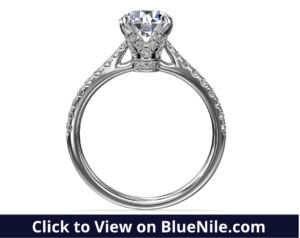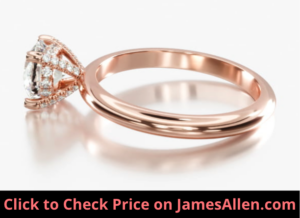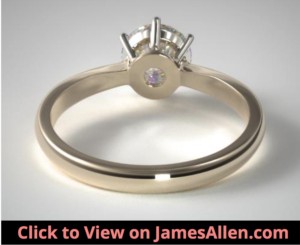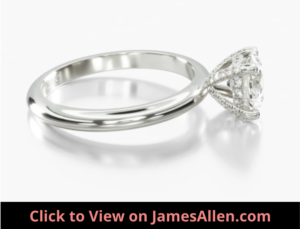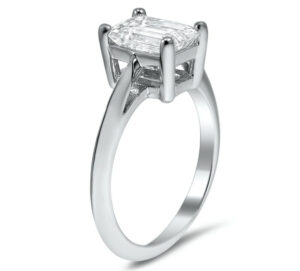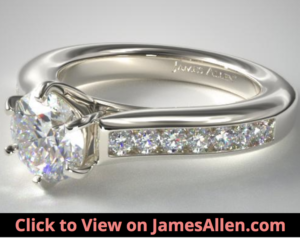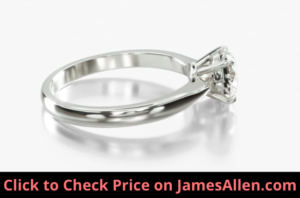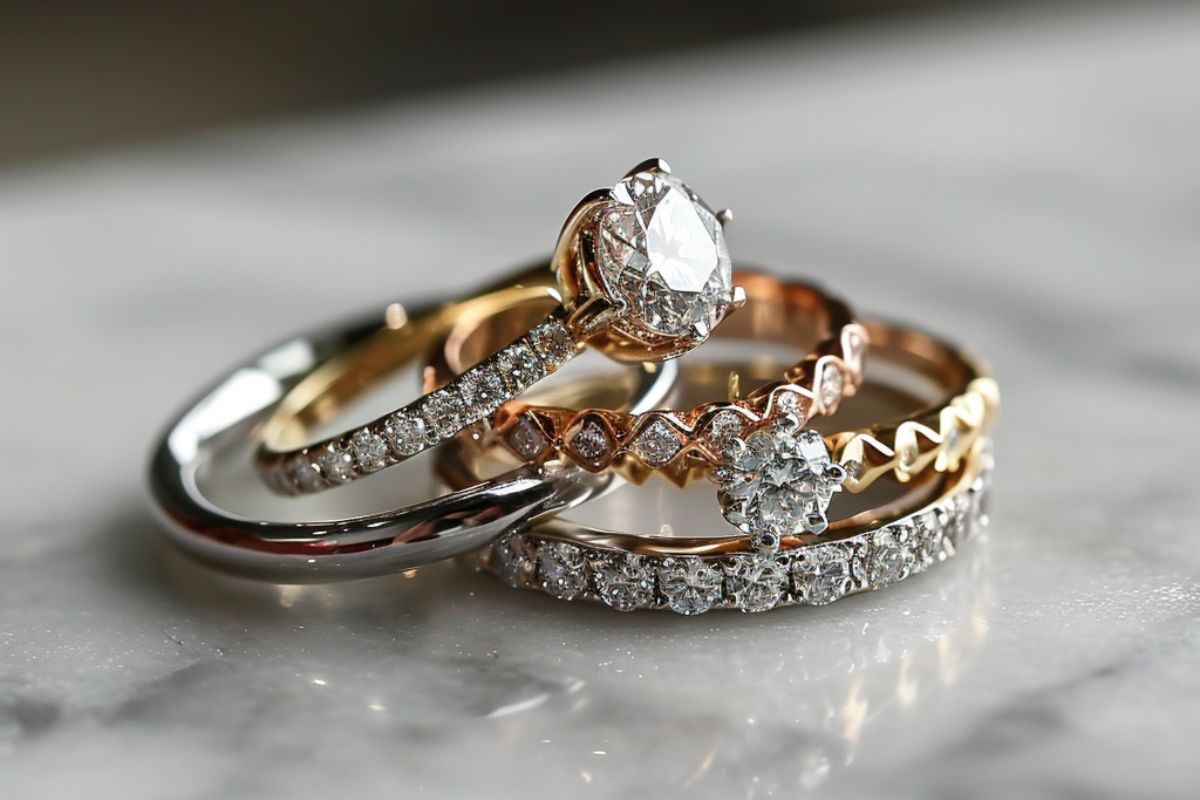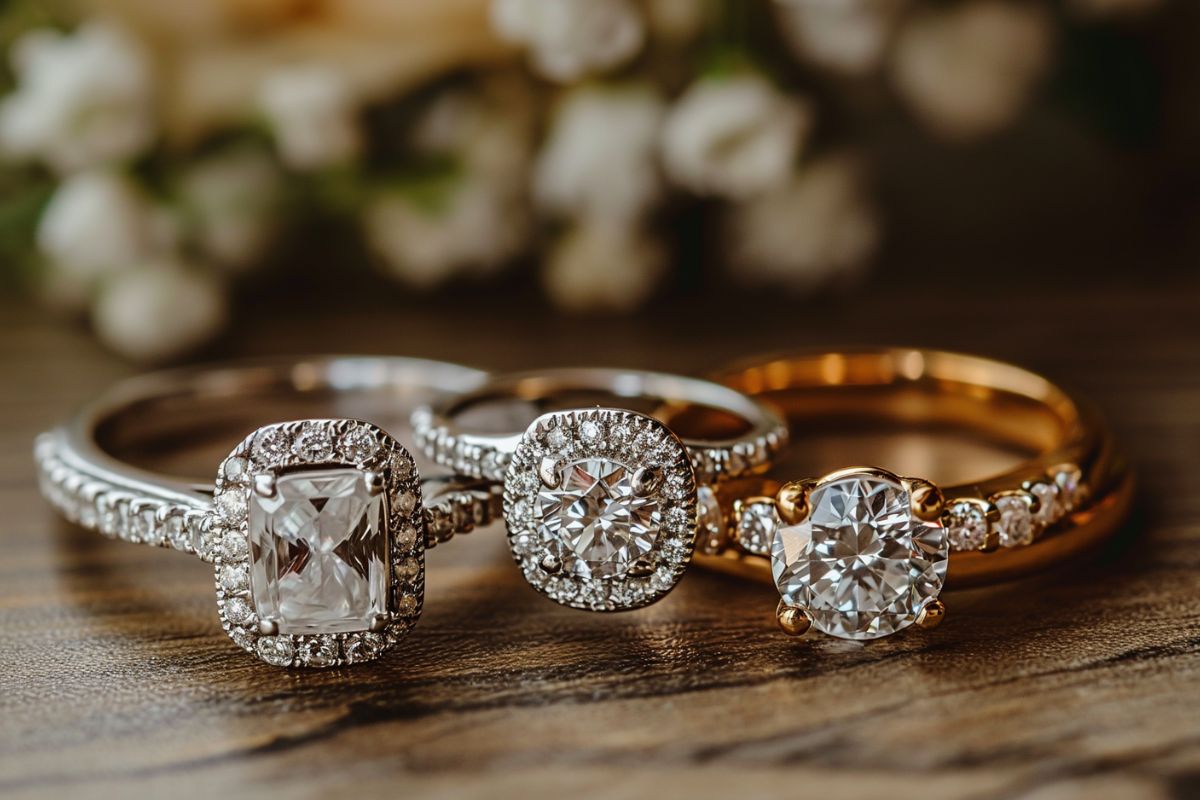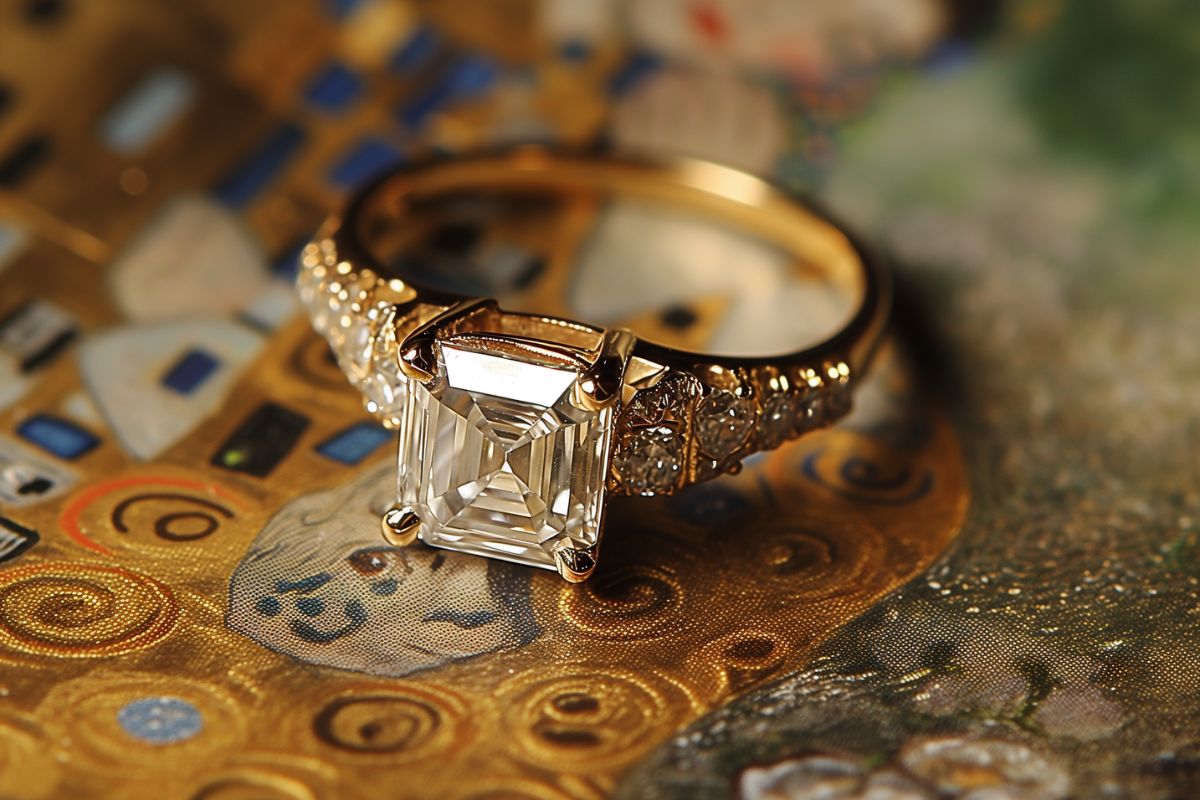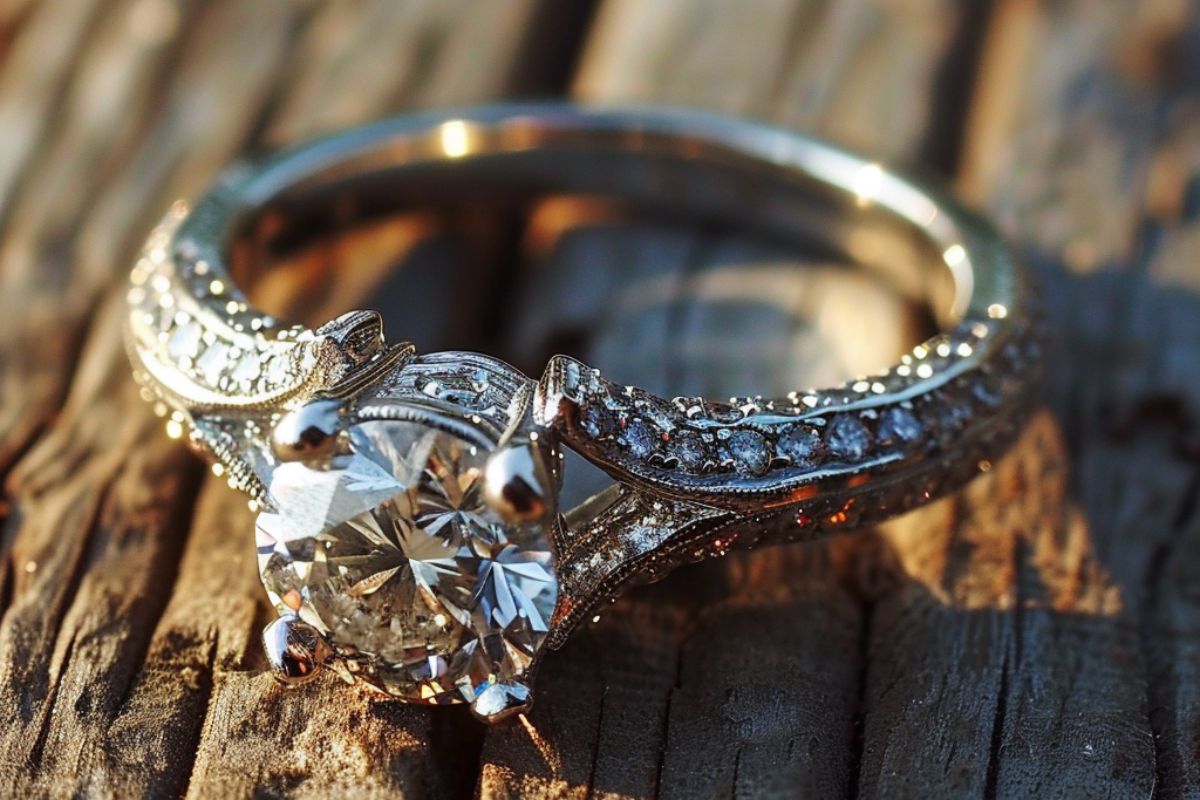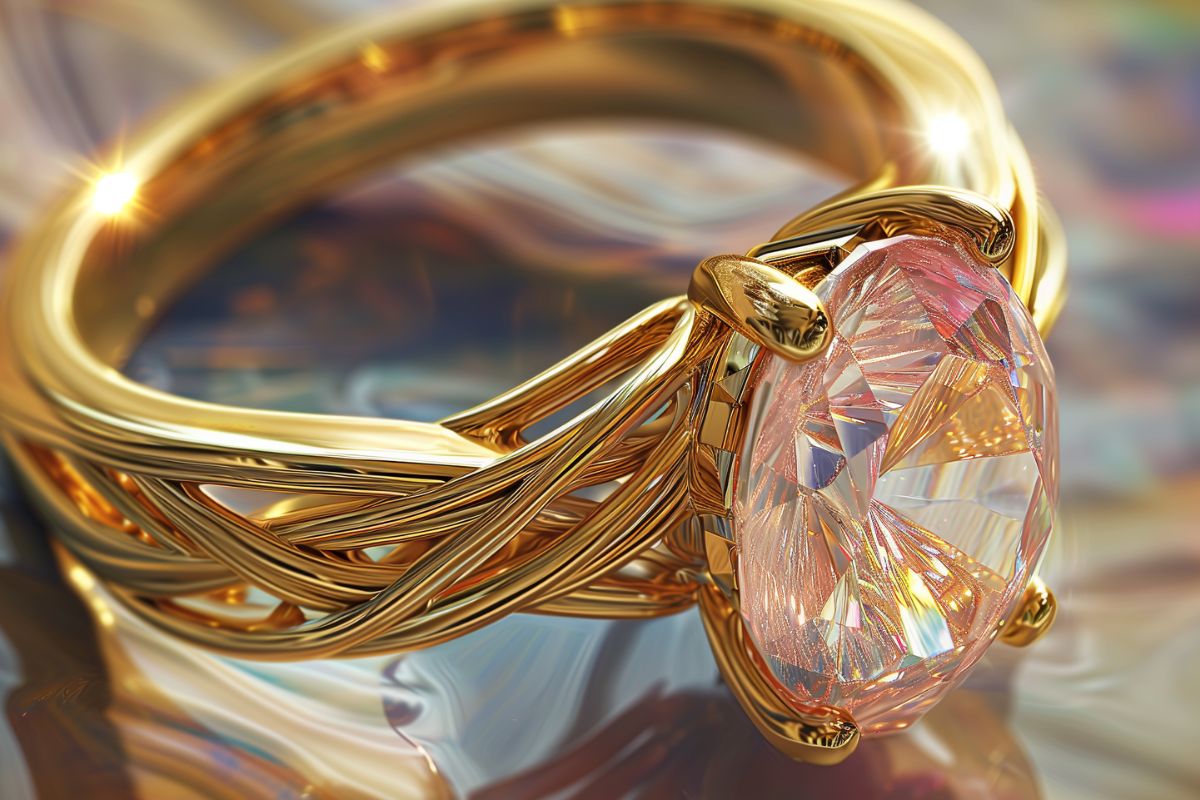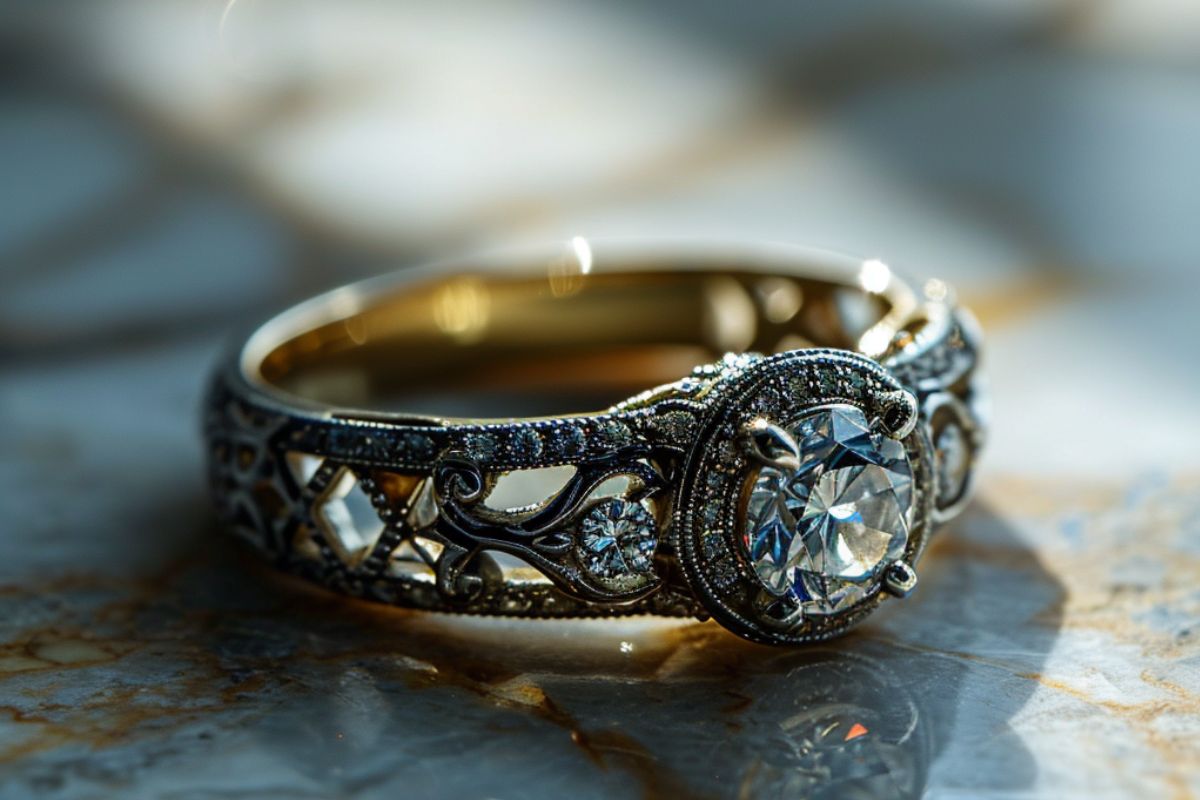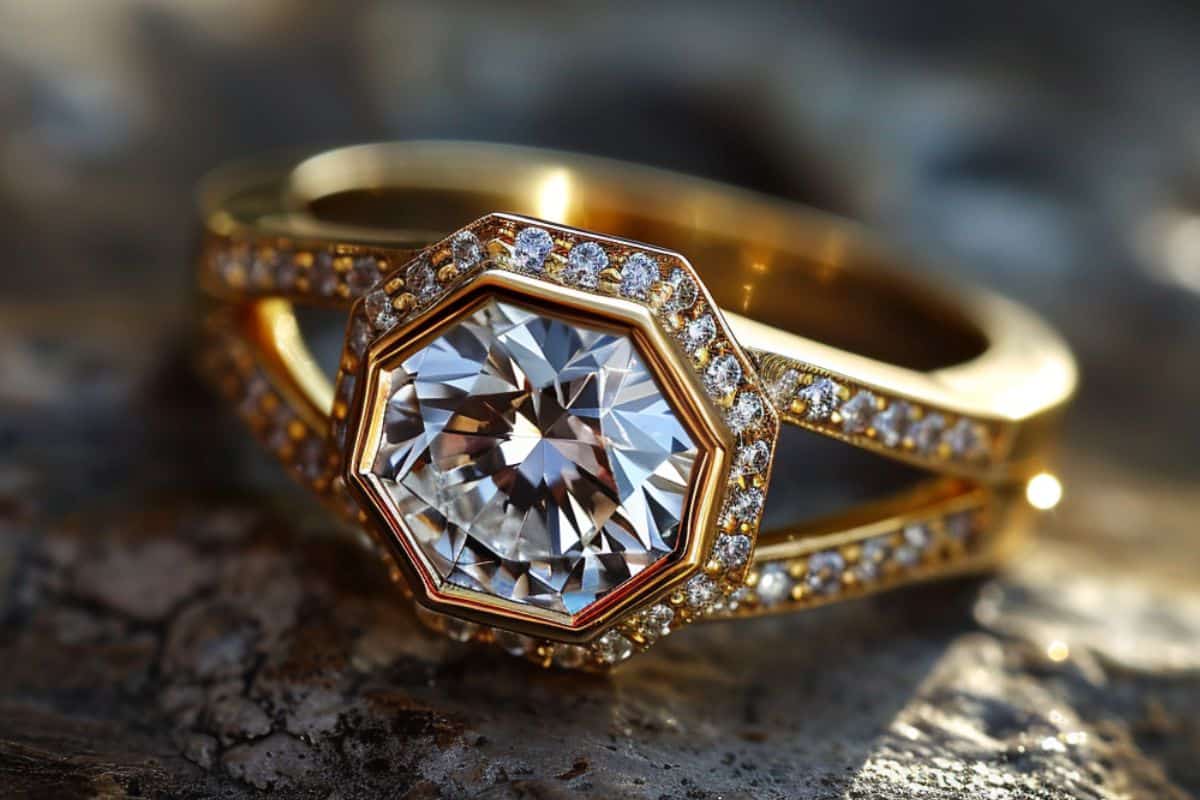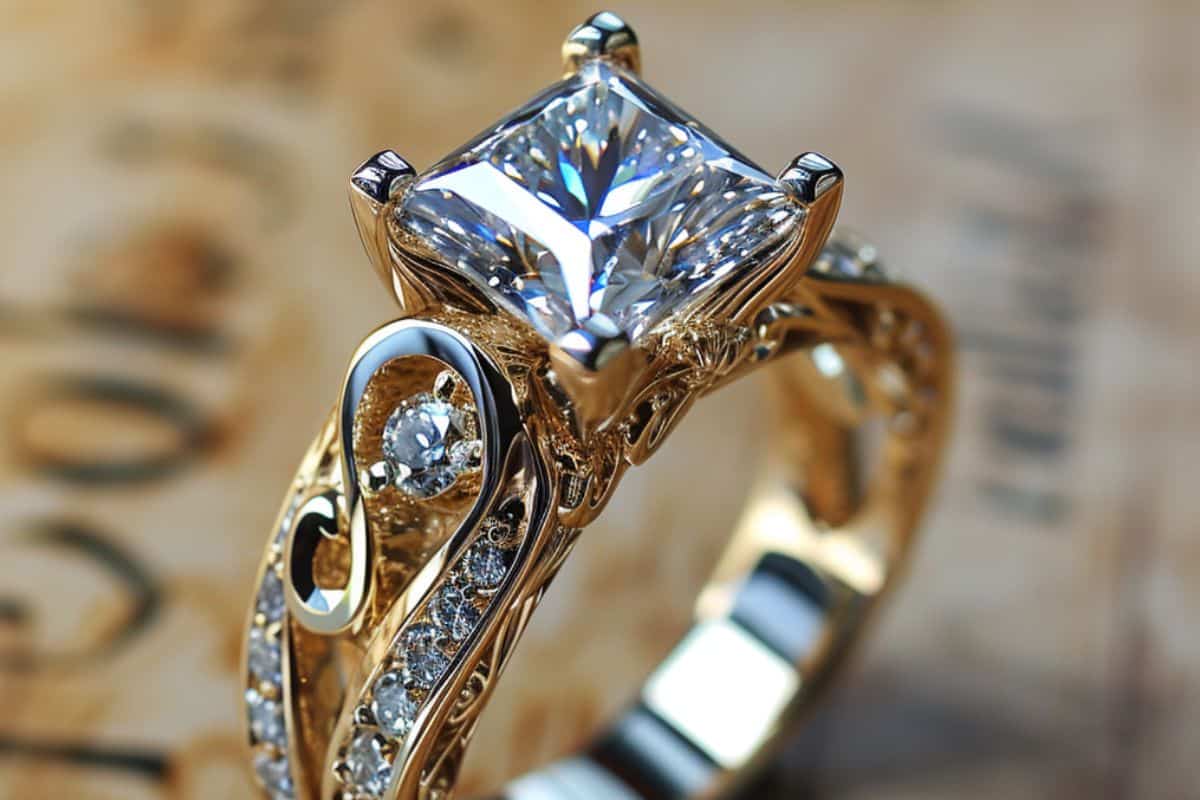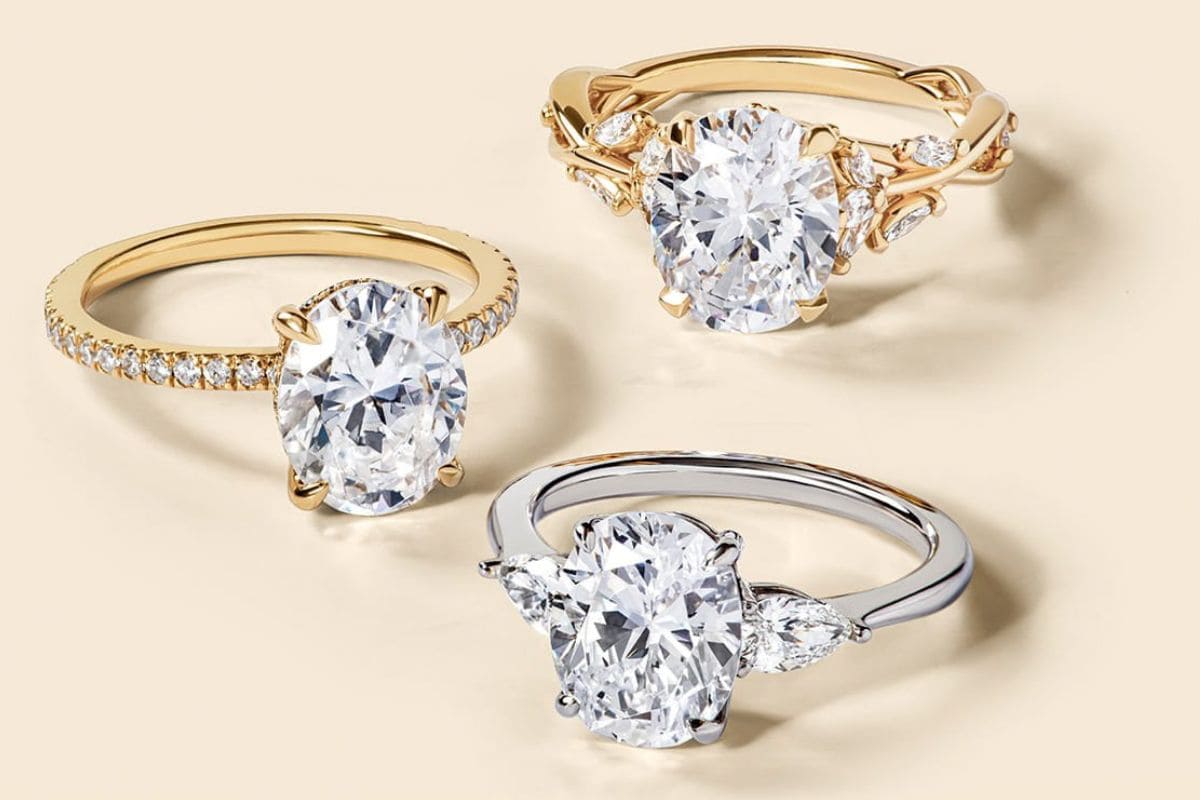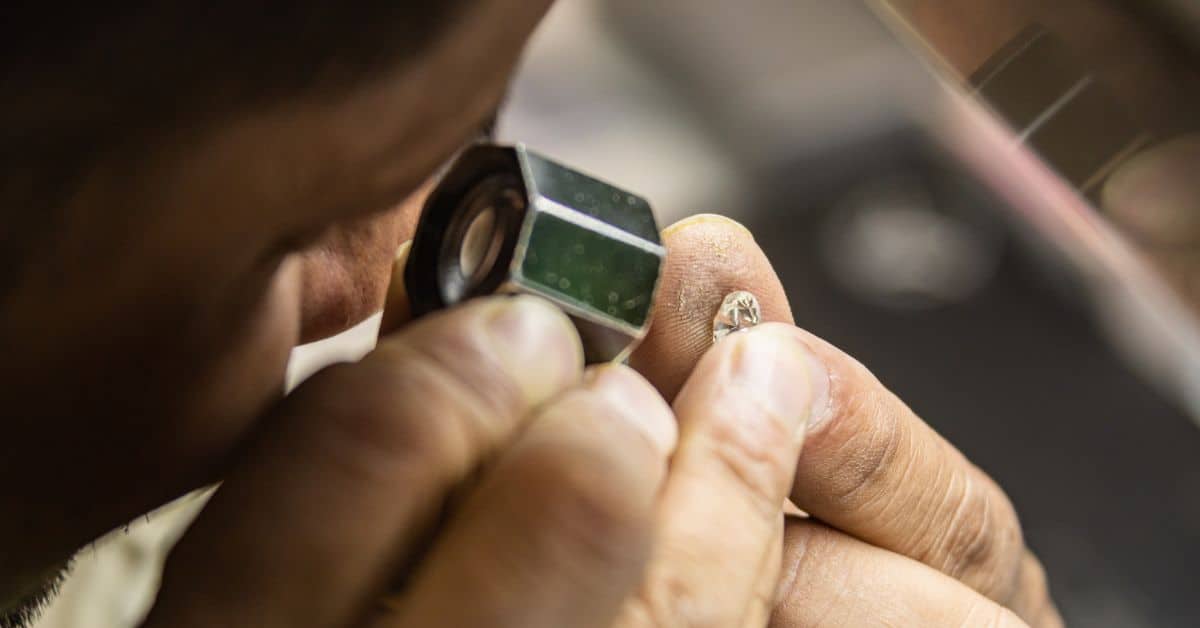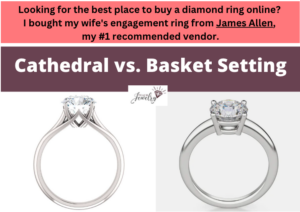
During the process of finding the right diamond ring, it’s natural to spend most of your time on the center diamond. But don’t neglect the importance of your setting.
There are a variety of settings available, and two types you’ll come across are cathedral and basket settings.
The main difference between them is cathedral settings include arches that extend upward to hold the diamond. It’s often held higher above the shank. A basket settings has a ring of metal that wraps around the pavilion to better secure the diamond.
We’ll compare cathedral versus basket settings, what you should know about each, their differences and similarities, and how to choose the right one for you.
What is a Cathedral Setting?
The distinguishing feature of a cathedral setting is the two arches that extend from the top of the shank to hold the main diamond.
The arches form triangle gaps that provide it a sense of elegance as it showcases the gem.
Cathedral settings can hold all types of gems and cuts from emeralds and sapphires to pear and marquise cut diamonds.
The image below showcases a cathedral setting holding a princess cut, and I’ve pointed out its namesake.
In addition, the shank can hold a variety of cuts and gems placed inside or around the metal.
To illustrate, here’s a cathedral pavé setting in 14K rose gold.
Notice how 0.5 carats of small diamonds cascade down each arch and onto the sides of the ring.
It’s a way to go beyond the traditional solitaire design with a cathedral setting.
What is a Basket Setting?
Basket settings are a variation of prong settings that include a horizontal metal bar that wraps around the center diamond.
It allows the diamond to sit in a basket instead of only being held in place by the prongs grasping its edges.
The main benefit is security because the pavilion isn’t exposed to hits and bumps. The diamond is also less likely to fall out if a prong is loose.
There are two common designs for basket settings.
The first is when the horizontal bar has a curved design that matches the rounded diamond. In other cases, like the version below, it’s straight.
Basket settings connect four-,six-, or eight-prong rings. They’re often used for round brilliant cuts but also secure other cuts and types of gems.
What are Differences Between Cathedral and Basket Settings?
1. Cathedral Settings are High Settings
Cathedral settings are often high settings, where the gem is placed higher above the top of the ring.
In the example below, check out how how the cathedral arches extend to hold the diamond.
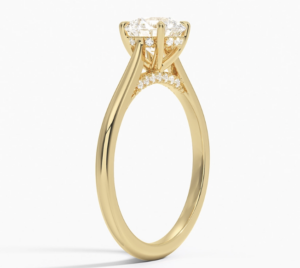
It provides more separation between the ring and the diamond, so it appears more prominent.
In a low setting, the diamond sits close to your finger.
There are many reasons buyers choose high settings, but the most common is it best displays the diamond.
The center diamond is the most important part of the ring, and placing it high off your finger maximizes the amount of light that can enter and exit it.
This improves its brilliance because more facets are exposed to light.
Their commonly used for diamonds with heavy carat weights to showcase its size.
The downside of a high setting is it’s more vulnerable to damage from scratches and bumps. It can snag on clothing and loosen the prongs.
This contrasts with low-set diamonds often found in basket settings.
I’ve posted an example below of a low basket setting.
Notice how the diamond is almost touching the top of the shank. It’s well protected by the basket surrounding each side.
The diamond sits tight on your finger, where it’s better protected.
The disadvantage is it lessens the prominence of your diamond, which to many buyers is a valuable trait.
It won’t collect as much light. Unless it’s a quality cut with minimal inclusions, it could appear dull.
On the other hand, there are high-set basket settings. If you want the benefits of a basket setting with a high-set diamond, explore options at jewelry retailers.
2. Basket Settings Offer More Security
The most popular reason buyers choose basket settings is for the security it provides the gem. Without the ring of metal wrapping around it, the pavilion is exposed.
In the example below, notice how much of the pavilion isn’t visible because of the basket.
Without it, the diamond could chip if it’s struck at a certain angle.
Additionally, if prongs bend backward and loosen, the diamond is less likely to fall out because it’s sitting in the basket.
Always repair broken prongs before wearing a diamond ring, but the basket gives you peace of mind with added protection.
Cathedral settings without a basket leave the diamond exposed. There’s nothing to prevent the diamond from chipping or bruising if it’s impacted on one of its sides.
This problem is exacerbated because of the high-setting, so you have to be more proactive in minimizing the damage to a diamond in a cathedral setting versus a basket setting.
As with any piece of jewelry, I recommend removing it during physical activity.
3. Cathedral Settings Enhance Brilliance
Cathedral settings enhance the brilliance of a diamond for two reasons.
The first is its high setting. More light enters it, bounces around, and reflects back to the viewer.
This is in contrast to a basket setting, which sits closer to your finger and can’t collect as much light.
Notice how with the diamond ring below, fewer of its facets are visible.
You’d only expect light to hit the table and return to the viewer.
As a contrast, cathedral settings expose all four sides of the diamond. Light can hit the diamond at every angle and sparkle no matter which way you twirl it.
There’s no basket hiding the pavilion.
Although you can choose a metal for your ring that has some sparkle such as platinum, it won’t have the same effect when light hits the basket as it will when it reflects off the diamond.
One way to compensate for this downside of basket settings is to choose a design with pavé or channel-set diamonds on the shank.
It’ll improve its brilliance when the ring is twirled because those diamonds on the ring will collect and return light.
This is especially valuable if you’ve chosen a step-cut diamond in the middle, surrounded by a basket.
Step-cuts already lack the light performance of brilliant cuts, so these added features could make a meaningful difference in its glimmer.
4. Basket Settings are More Difficult to Clean and Maintain
Basket settings include more nooks and crevices than cathedral settings. So they’re harder to clean and maintain.
In this way, basket settings are comparable to trellis settings.
Dirt and grime can accumulate around the basket over time, which can’t always be removed with an at-home cleaning job.
As an example, take a look at the knife edge ring below.
There are many places surrounding the diamond where debris can build.
So have basket settings cleaned by a professional once or twice per year.
Cathedral settings don’t feature the same amount of small spaces.
The arches form large, open triangles, which don’t collect debris as easily. If it does, it’s easier to clean yourself.
In most cases, you can combine warm water with dishwashing solution and let it soak for 30-40 minutes. Any dirt that refuses to fall out can be wiped away with a soft cloth.
5. Cathedral Arches are Included on Multiple Types of Settings
The arches on cathedral settings aren’t unique to prong settings. Although prongs are the most popular way to hold a diamond in this style, they’re also found in bezel settings.
Bezel settings feature a ring of metal that wraps around the outer edge of a diamond to secure it in place.
Some bezel settings are held in place by the cathedral arches. They reach from the top of the shank and attach to the ring of metal.
This provides the bezel with added height to improve its brilliance. The reason you might choose cathedral arches for a bezel setting is because bezels cover more of the diamond’s facets compared to prongs.
The high cathedral arches help compensate for the lack of light performance.
Basket settings, on the other hand, are only found with prongs. If you’re looking for a bezel or tension setting, you won’t have the option to secure it in a basket.
Do They Have Similarities?
1. Cathedral Settings can Include a Basket
Some cathedral settings also include the basket wrapping around the diamond.
It combines the best qualities about each, offering you the elegance and style of a cathedral setting with the security of a basket setting.
You’ll sacrifice some brilliance normally offered by a high cathedral setting for the protection from the basket. But if you can’t decide between one or the other, this is an option.
2. Embellishments
Additionally, both provide room for embellishment.
You might opt more diamonds, gemstones, or milgrain on the ring instead of a traditional solitaire setting.
For example, the below cathedral engagement ring includes channel-set diamonds halfway around the shank.
Sixteen diamonds line the shank, placed in a small crevice. It still features the signature arches, but there’s room on the band for added sparkle.
As another example, this cathedral setting has milgrain lining the marquise-cut accents.
Accents are placed along the arches, and the rounded shank also includes those enhancements.
The basket also leaves room for embellishment. Some buyers don’t want an additional line of metal on their ring, so they instead use the space for more diamonds.
This engagement ring has a French cut basket setting with diamonds lining the band, prongs, and basket. It adds glimmer to the piece without increasing the carat weight of the center diamond.
3. Price
You also won’t find significant price differences between cathedral and basket settings. Cathedrals have the two arches added to the ring, while basket settings have the ring of metal surrounding the diamond.
These added features result in a similar cost.
For example, this petite cathedral setting in 14K white gold costs $650.
This basket setting in 14K white gold costs $770.
You’ll incur additional costs on both types of settings by adding more diamonds on the shank to complement the main one.
How to Decide Between Cathedral and Basket Settings
Basket and cathedral settings are popular options for showcasing a ring’s center gem.
You should consider a cathedral setting if:
- You have a large diamond and want to maximize its brilliance
- You’ll remove the ring during physical activity because of its high setting and lack of protection
- You want room on the ring and its arches to add diamond accents or other enhancements
A basket setting may be right for you if:
- Preventing the diamond from chipping or being bruised is most important
- You aren’t concerned about diminishing its brilliance by covering the pavilion
- You want a low setting that keeps it close to your finger
Explore both designs at jewelry stores, and pair them with a variety of diamond cuts and other types of gems.
By examining how your choice of gem fits with cathedral and basket setting, you’ll learn which one fits your style.

Jacob Clarke
Jacob Clarke is the founder of TeachJewelry.com.
He earned an Applied Jewelry Professional Diploma from the Gemological Institute of America (GIA) and now brings you essential information about diamonds, settings, and more.
Jacob has consulted with leading jewelry brands, and his work has been cited in Clean Origin, Diamond Nexus and industry publications.
He's also a member of the International Gem Society.
He enjoys discussing jewelry with readers, so contact him with any questions at jacob.clarke@teachjewelry.com.


